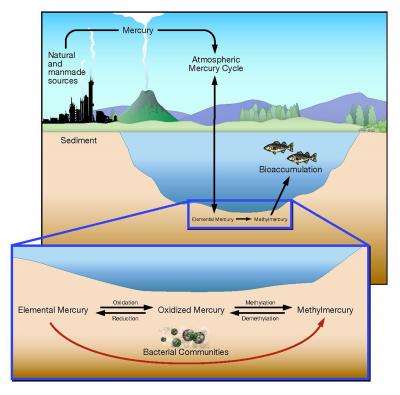Research reveals new challenges for mercury cleanup

More forms of mercury can be converted to deadly methylmercury than previously thought, according to a study published Sunday in Nature Geoscience. The discovery provides scientists with another piece of the mercury puzzle, bringing them one step closer to understanding the challenges associated with mercury cleanup.
Earlier this year, a multidisciplinary team of researchers at Oak Ridge National Laboratory discovered two key genes that are essential for microbes to convert oxidized mercury to methylmercury, a neurotoxin that can penetrate skin and at high doses affect brain and muscle tissue, causing paralysis and brain damage.
The discovery of how methylmercury is formed answered a question that had stumped scientists for decades, and the findings published this week build on that breakthrough.
Most mercury researchers have believed that microbes could not convert elemental mercury—which is volatile and relatively inert—into methylmercury. Instead of becoming more toxic, they reasoned that elemental mercury would bubble out of water and dissipate. That offered a solution for oxidized mercury, which dissolves in water. By converting oxidized mercury into elemental mercury, they hoped to eliminate the threat of methylmercury contamination in water systems.
ORNL's study and a parallel study reported by Rutgers University, however, suggest that elemental mercury is also susceptible to bacterial manipulation, a finding that makes environmental cleanup more challenging.
"Communities of microorganisms can work together in environments that lack oxygen to convert elemental mercury to methylmercury," study leader Baohua Gu said. "Some bacteria remove electrons from elemental mercury to create oxidized mercury, while others add a methyl group to produce methylmercury."
Mercury is a toxin that spreads around the globe mainly through the burning of coal, other industrial uses, and natural processes such as volcanic eruptions, and various forms of mercury are widely found in sediments and water. Methylmercury bioaccumulates in aquatic food chains, especially in large fish.
The fight against mercury pollution involves scientists with expertise in chemistry, computational biology, microbiology, neutron science, biochemistry and bacterial genetics. Other ORNL efforts are focusing on when, where and why bacteria are producing methylmercury.
"Our research allows us to understand generally where and how bacteria might produce methylmercury so that we can target those areas in the future," said ORNL's Liyuan Liang, a co-author and director of the DOE-funded mercury research program. "We are trying to understand the process of microbial mercury methylation. Once we understand the process, we can begin to form solutions to combat mercury pollution."
More information: Nature Geoscience DOI: 10.1038/ngeo1894
Journal information: Nature Geoscience
Provided by Oak Ridge National Laboratory
















